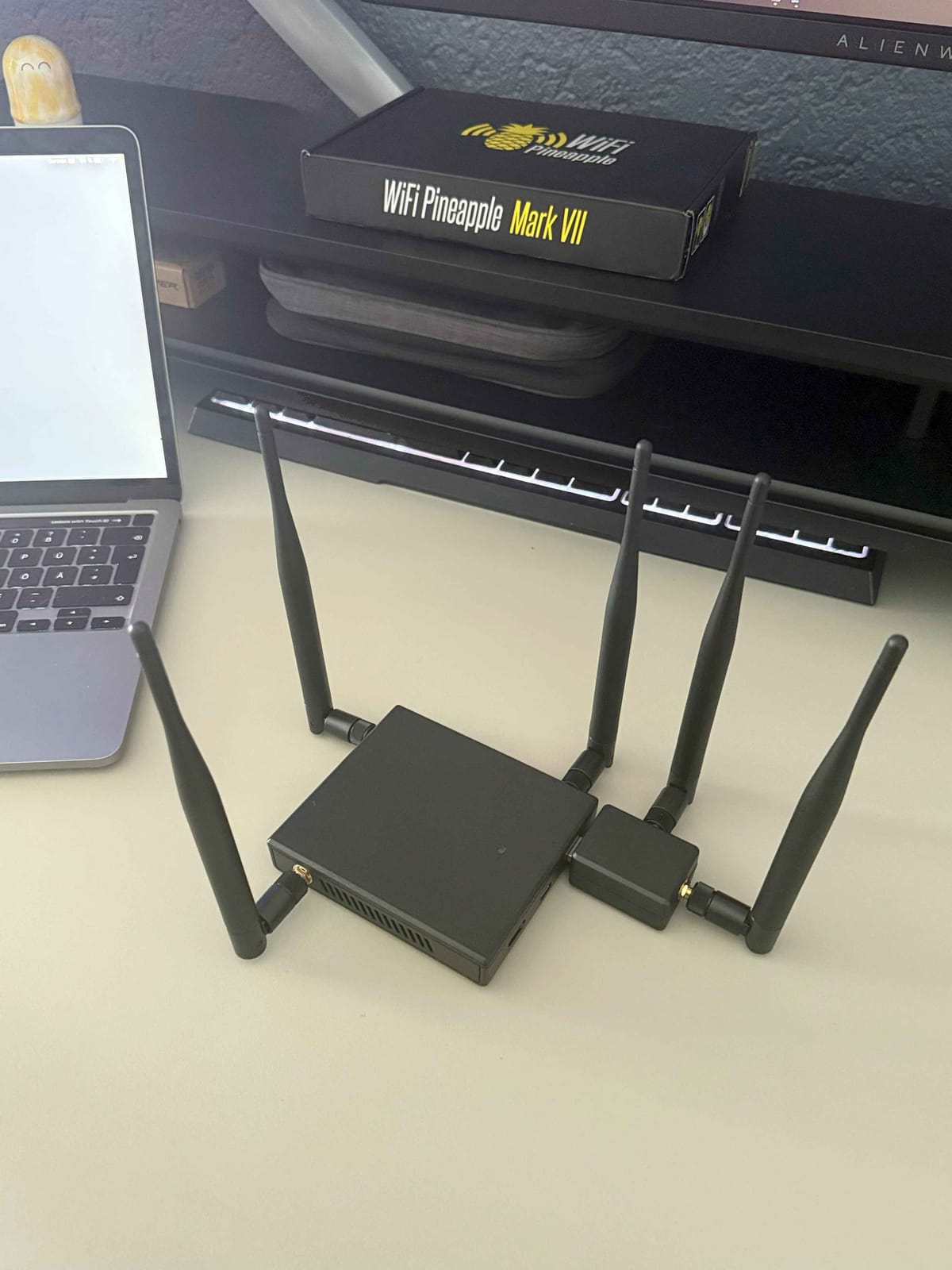Project: HAK5 WiFi Pineapple Mark VII + AC Tactical Kit - First Exploration

Today marks the arrival of an exciting addition to my lab: the WiFi Pineapple Mark VII, bundled with the AC Tactical Kit. Until now, my knowledge about this tool has been purely theoretical, from reading blogs, watching videos, and understanding its reputation in the cybersecurity world. Finally having it in my hands means I can bridge the gap between theory and practice.
Understanding the WiFi Pineapple Mark VII
The WiFi Pineapple Mark VII is a purpose-built wireless auditing and attack platform. Unlike standard WiFi adapters, it operates as a fully independent device, running its own OpenWRT-based operating system with a user-friendly web interface. This makes it extremely versatile for penetration testers and red teams alike.
With tools like PineAP, the Pineapple can perform both passive and active reconnaissance, capture probe requests from devices looking for trusted networks, and respond to those probes to impersonate legitimate access points. It automates complex attacks, manages logs, and allows remote control through SSH or web browser.
Key features:
- Standalone operation (no laptop required)
- Real-time monitoring and logging
- Installable modules for expanded functionality (like Evil Portal)
- Autonomous attack campaigns once configured
This device is not only used for offensive testing - defenders and auditors also rely on it to understand potential WiFi vulnerabilities in their environments.
What the AC Tactical Kit Adds
The AC Tactical Kit elevates the core Pineapple by adding practical hardware upgrades for field use:
- Dual-Band Support (2.4 GHz & 5 GHz): Critical for testing modern environments that prioritize faster 5 GHz networks.
- High-Gain Antennas: Increased range and better signal reliability.
- Rugged Carrying Case: Weather-resistant, discreet, and portable.
- Extended Power Options: Enables prolonged deployments, useful for dropbox scenarios.
- USB Expansion Ports: Ideal for LTE dongles, storage, or additional tools.
This makes the setup highly mobile, efficient, and perfect for longer engagements, whether stationary or on the move.
Practical Applications and Scenarios
Covert Red Team Deployments
The Pineapple can be deployed discreetly inside a target environment to passively collect data or actively lure devices into connecting to rogue networks. With the Tactical Kit’s battery support, it operates autonomously for extended periods, capturing credentials and mapping the wireless landscape.
Wireless Security Audits
Ideal for enterprise assessments, it scans for weak points in WiFi configurations, tests client behavior, and helps organizations understand the risks of misconfigured networks, especially when dual-band coverage is essential.
Security Awareness Training
Used in controlled environments, it demonstrates how easily employees can be tricked into connecting to malicious networks, underlining the importance of safe WiFi practices.
Advanced Reconnaissance
With its high-gain antennas, it’s perfect for long-range monitoring, identifying hidden SSIDs, observing client behavior, and mapping signal coverage even from outside the premises.
Multi-Vector Attack Chains
Captured credentials can be immediately integrated into further exploitation steps, and with remote management through VPN tunnels, it acts as a powerful remote foothold in red team operations.
Testing WPA Enterprise & Captive Portals
The Pineapple can simulate enterprise login pages and captive portals to capture authentication attempts, testing the resilience of network access control mechanisms.
Notable Capabilities: Deauthentication & Evil Portal
Among its most impactful features is deauthentication. By sending forced disassociation packets, the Pineapple can kick clients off their legitimate networks, causing devices to reconnect automatically to a malicious rogue access point.
Once devices connect, the Evil Portal module can present convincing fake login pages, harvesting user credentials like WiFi passwords or corporate logins. These combined tactics show how attackers exploit both technical flaws and human trust.
What makes these attacks particularly dangerous is how silently they operate. Most users have no visual indication that they’ve been disconnected or are connecting to a malicious access point. Many phones, laptops, and IoT devices reconnect automatically to familiar-looking networks, especially if SSID names are duplicated.
An attacker could, for instance, simulate the corporate WiFi network, collect credentials over time, and then use those credentials to pivot further into the internal network. Even multi-factor authentication is not always a perfect defense, especially if attackers combine Evil Portal with social engineering tactics.
Furthermore, deauth attacks can be used to force devices to reveal handshakes, which can then be captured and subjected to offline cracking attempts. While WPA3 addresses some of these risks, many environments still use WPA2, leaving them open to such attack strategies.
My Approach Moving Forward
Since this is my first time working hands-on with the Pineapple, my initial steps will involve controlled lab testing. I plan to familiarize myself with its modules, test its range and reliability, and practice covert deployments.
I’m especially eager to see how it performs in noisy urban environments, where high-density WiFi traffic creates both challenges and opportunities. Once comfortable with the basics, I aim to integrate the Pineapple into broader attack chains, potentially alongside tools like Flipper Zero or remote management via VPN.
Ultimately, this project aligns perfectly with my goal of building a modular, portable pentesting toolkit that covers physical, network, and wireless attack surfaces.
Updates will follow as I dive deeper into field testing and real-world scenarios.